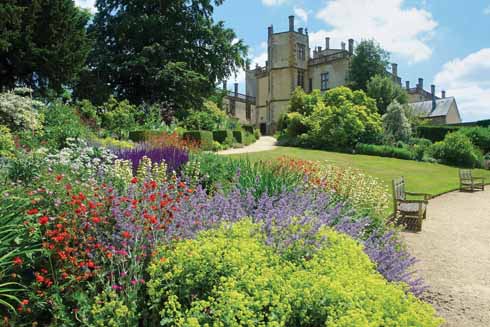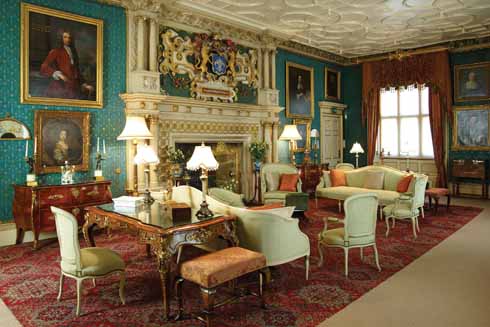Sherborne Castle Estates – Much more than a castle with gardens
Peter Booton goes behind the scenes at the Sherborne Castle Estates
Published in April ’14
The Sherborne Castle Estates in Dorset encompass some 13,000 acres of land and are owned by the Wingfield Digby family whose ancestral home is Sherborne Castle, which was built in 1594 by Sir Walter Raleigh. Following Raleigh’s imprisonment for suspected treason in 1603, he was forced to surrender the castle and his estates to the Crown. A favoured diplomat of King James I, Sir John Digby, bought the castle in 1617. Raleigh was executed the following year.
The estates are run on a day-to-day basis by Mr and Mrs John Wingfield Digby and their son Edward, with their resident land agent, William Beveridge, in overall charge. 51 full-time and thirty part-time members of staff are employed on the estates, which comprise a mix of in-hand and tenanted farms, woodland, and over 500 agricultural, residential and commercial properties. The last includes three public houses – the Digby Tap in Sherborne, the Lime Tree Inn at Thornford, and the Three Elms at North Wootton – in addition to various shops in Sherborne ranging from an optician to a fish and chip shop.
Every property, including the castle and the properties lived in by the owners, are cared for by the estate’s maintenance team who are based in former forestry mill buildings at estates yard in New Road, Sherborne. They undertake a wide diversity of tasks and are led by foreman, Perry Rowe, who has worked on the estates for more than thirty years. The team consists of plumbers, carpenters and joiners, an electrician and two apprentices: Ashton, who is training to be a joiner, and Nick, who is learning the skills of plumbing. Although much of their everyday work involves minor repairs such as fixing dripping taps and replacing broken panes of glass, larger tasks include the restoration of old cottages and modernisation of tenanted properties. Sometimes there are more unusual jobs to tackle. If there is a heavy fall of snow on the castle roof, the maintenance team lend a hand to clear it. They also made the wooden wheels of the two cannons at the entrance to the castle, and help to set up the annual Pack Monday Fair; the site also hosts Sherborne Castle Country Fair, a popular event that has raised a staggering £849,267 for local good causes since the first fair in 1996.
Any timber item that is needed, such as new doors and windows, is made in the joinery workshop, a long, single-storey building in the estates yard. Nearby are the stores where all manner of items from galvanized farm gates to guttering are kept. Gates throughout the estates can be recognised by a traditional ‘gun-stock’ shaped section of steel, incorporated in their construction. Alongside the stores is another sizeable building in which Sherborne stone is processed and stored.
The stone is quarried out of Frogden quarry, to the east of the town, and is used in a number of Sherborne’s historic buildings and its more recently built schools, as well as in the renovation of Sherborne House. The stone yard operates as a commercial enterprise, supplying customers with lintels, mullions, coping, internal flooring and fireplaces, in addition to walling in the form of random rubble and ashlar. Martin Dodge is in charge of the stone yard and is assisted by four permanent members of staff. Surprisingly, they don’t call themselves stone-masons. Martin explains: ‘most of the work is done by machine, so we’re more machine operators than masons, “super-sawyers”, if you like. We use saws, but we can turn our hand to what most people would see as masonry, although it isn’t masonry as in the traditional form using a hammer and chisel. When any specialist masonry work is required, we use the services of two freelance masons.’ A new fossil bed was recently discovered at Frogden quarry, with its stone displaying particularly striking fossils. As this type is rare it will probably only be used in tile form, as specialist artwork perhaps, or as an inlaid feature in tables.

The manager of Home Farm, Paul Carter (centre), and John Wingfield Digby (right) examining mature grapes at picking time
Tenanted farms on the Sherborne Castle Estates span an area east-west from Goathill to Thornford, and north-south from just north of Sherborne to Pulham. Home Farm at Bishop’s Caundle accounts for some 2600 acres and is farmed in-hand by its owners, Mr and Mrs John Wingfield Digby. The farm, managed by Paul Carter, is a predominantly arable enterprise. It also runs 140 beef suckler cows and encloses a vineyard of more than seven acres begun by John Wingfield-Digby in 1981. Viticulture was introduced to the Sherborne Castle Estates by Bishop Roger of Salisbury, builder of the ‘Old’ castle, who planted a vineyard on the southern slopes of the lake alongside his castle in 1164.
Six varieties of grapes are grown in the vineyard at Home Farm; Bacchus, Seyval Blanc, Reichsteiner, Pinot Noir, Pinot Blanc and Schönburger. When the grapes are ready for picking, around twenty local people assist with the task. Picking is usually done two days a week for three to four weeks, depending on the size of the crop. As each variety ripens at a different time the grapes are picked on the sugar and acid levels required to make the alcohol that is wanted and the dryness. The wine is then processed and bottled by a specialist wine-maker in Somerset and returned to Home Farm for labelling by the farm-workers. 15,000 bottles of wine are produced annually. These include a sparkling brut, sparkling rosé, special reserve – a blend of four grape varieties – and wine brandy. Before any wine can be sold it has to receive a PGI (Protected Geographical Indication) test and approval in order to be called a regional Dorset wine. It is sold in the shop at Sherborne Castle, and available from a number of retail outlets throughout Dorset.
The 42-acre gardens surrounding the castle are open in 2014 between 1 April and 30 October, although they were also open for the ‘Spring Bulbs and Daffodils’ Weekend on 22-23 March. In 2013 the head gardener, Tim Stiles, and his team planted 25,000 daffodils, continuing the tradition of planting similar quantities since Tim took over the leading role nineteen years ago. Amazingly, considering how neat and tidy the gardens always are, Tim only has two full-time gardeners and one part-time helper, plus usually a university student, to assist him. The team also maintain the gardens of the owners’ properties.
Although he enjoys ‘hands-on’ gardening whenever possible, Tim’s role as head gardener is largely a managerial one, with the benefit of computer-based technology. In 2002 Tim implemented a computerised system with a database that maintains a record of the 5000 trees within the estates. Using this he can rapidly identify each tree, with its Latin name and size, when it was last inspected and what maintenance it has received. The database is linked to a software programme which allows Tim to pinpoint each of the 1000 street trees within the estates on an aerial map. The weather is another important factor in caring for the gardens and the safety of visitors. Tim relies on a sophisticated weather station connected to a computer in his office to keep abreast of changing weather conditions, particularly high winds which could cause damage to trees and endanger visitors. If there is any chance of this happening, a decision is taken to close the gardens.
At present, Tim and his team are in the process of resurfacing all of the paths in the gardens, a total of 1.7km, using 120 tons of stone. Work is also underway to improve the attractiveness and presentation of the flower beds by gradually introducing more herbaceous perennials to replace the existing woody perennials. A recent audit by tree specialists has confirmed that the gardens contain a number of particularly fine specimens of their type which can be considered ‘Dorset champions’ and worthy of inclusion on a national database of important trees.
Sherborne Castle and Gardens welcomed 33,734 visitors in 2013, as well as hosting television programmes, a new film soon to be released and a number of commercial photo shoots. In addition to the usual annual Country Fair and Craft and Garden Fair, two exciting new events are planned this year: a ‘Behind the Castle Music Festival’ on 14 June, and a Civil War re-enactment by The Sealed Knot over the Bank Holiday weekend – 23-25 August. Various other organised events take place during the year and the Castle and Gardens, a popular location for weddings since 1999, can also be booked for private functions.
The castle is not ‘put to bed’ for the winter closed season as it is used for family functions. However, it does undergo an extensive cleaning regime over winter which is carried out by the housekeeper and the custodians, who look after the castle throughout the year, with assistance from the part-time maintenance staff. During the open season regular cleaning is carried out by the housekeeper, who is responsible for making sure that the castle is clean and presentable for visitors.
The elegantly appointed state rooms are open to the public and display a wealth of fine objects collected over a period of nearly four centuries by the Digby family. These include family portraits, furniture, and porcelain from the Far East. There are significant collections of art and antiques, too, and the despatch box said to have been used for a royal marriage proposal. Title deeds, leases, estate accounts, maps and many other important documents are housed in the archive which is cared for by the archivist, Ann Smith. Although a number of these historic documents are not on display to the public, for preservation purposes, some can be viewed as colour copies in the museum (located in the castle cellars) where there are relics from the Civil War.
Rounding off any tour of the castle and gardens is a visit to the tearoom and shop, where there is a selection of food and drink from local suppliers, head gardener’s honey and coffee roasted on the Estate. Sherborne Castle wine is of course one of the best sellers – antlers from the deer park are popular too – and, possibly in the future, visitors might be able to take home game and venison. Food miles certainly aren’t an issue. ◗
❱ www.sherbornecastle.com





